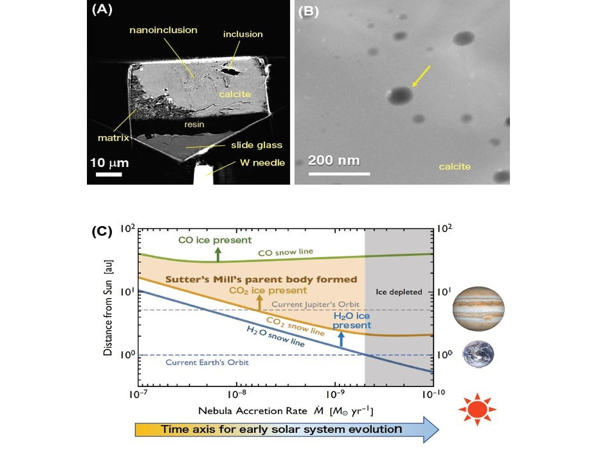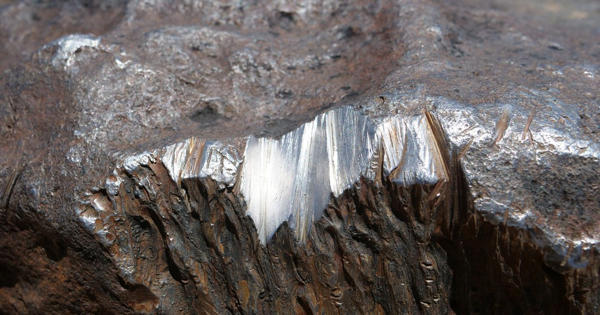Water is plentiful in the solar system. Scientists have discovered ice on the moon, in Saturn’s rings and comets, liquid water on Mars and beneath the surface of Saturn’s moon Enceladus, and traces of water vapor in Venus’ scorching atmosphere. Water is thought to have played an important role in the early evolution and formation of the solar system, according to research. To learn more about this role, planetary scientists have looked for evidence of liquid water in extraterrestrial materials such as meteorites, the majority of which are made up of asteroids that formed early in the solar system’s history.
Researchers recently discovered carbon-rich water in what is described as ancient meteorites, which played an important role in the early evolution and formation of the solar system. According to the most recent report, water is abundant in the solar system. Even beyond Earth, scientists have discovered ice on the moon, in Saturn’s rings and comets, liquid water on the Red Planet and beneath the surface of Saturn’s moon Enceladus, and water vapor traces in Venus’s scorching atmosphere.
Planetary scientists have searched for evidence of liquid water in extraterrestrial materials such as meteorites, most of which originate from asteroids that formed in the early history of the solar system.
To delve deeper into the role, planetary scientists have sought evidence of liquid water in extraterrestrial materials such as meteorites, the majority of which were formed from asteroids in the early history of the solar system. In the context of hydrous minerals, which are fundamentally solids in certain iron and have molecule water integrated within them, researchers have discovered water as hydroxyls and molecules in meteorites.
Water has even been discovered in meteorites as hydroxyls and molecules in the context of hydrous minerals, which are essentially solids with some ionic or molecular water incorporated within them. “Scientists further expect that liquid water should remain as fluid inclusions in minerals that precipitated in aqueous fluid,” says Dr. Akira Tsuchiyama, Visiting Research Professor at Ritsumeikan University (or, to put it simply, formed from drops of water that contained various other things dissolved inside them). Scientists have found such liquid water inclusions inside salt crystals located within a class of meteorites known as ordinary chondrites, which represent the vast majority of all meteorites found on Earth though the salt actually originated from other, more primitive parent objects.
Prof. Tsuchiyama and his colleagues wanted to know if liquid water inclusions can be found in calcite, a type of calcium carbonate derived from asteroids that formed very early in the history of the solar system. They examined samples of the Sutter’s Mill meteorite, a carbonaceous chondrite formed in an asteroid 4.6 billion years ago. The findings of their investigation, led by Prof. Tsuchiyama, have been published in the prestigious journal Science Advances.

The researchers examined the Sutter’s Mill meteorite fragments using advanced microscopy techniques and discovered a calcite crystal with a nanoscale aqueous fluid inclusion containing at least 15% carbon dioxide. This discovery demonstrates that calcite crystals in ancient carbonaceous chondrites can contain not only liquid water but also carbon dioxide.
The presence of liquid water inclusions within the Sutter’s Mill meteorite has intriguing implications for the parent asteroid’s origins and the early history of the solar system. The inclusions are most likely the result of the parent asteroid forming with bits of frozen water and carbon dioxide inside. This would necessitate the asteroid forming in a region of the solar system cold enough for water and carbon dioxide to freeze, and these conditions would place the site of formation far outside of Earth’s orbit, possibly even beyond Jupiter’s orbit.
The asteroid must then have been transported to the inner solar system, where fragments could collide with the planet Earth. This assumption is consistent with recent theoretical studies of the evolution of the solar system, which suggest that asteroids rich in small, volatile molecules like water and carbon dioxide formed beyond Jupiter’s orbit before being transported to areas closer to the sun. The gravitational effects of Jupiter and its migration are the most likely causes of the asteroid’s transport into the inner solar system.
To summarize, the discovery of water inclusions within a carbonaceous chondrite meteorite from the early history of the solar system is a significant accomplishment for planetary science. Prof. Tsuchiyama states proudly, “This achievement demonstrates that our team was able to detect a tiny fluid trapped in a mineral 4.6 billion years ago.”
His team’s work can provide important insights into processes at work in the early history of the solar system by obtaining chemical snapshots of an ancient meteorite’s contents.














